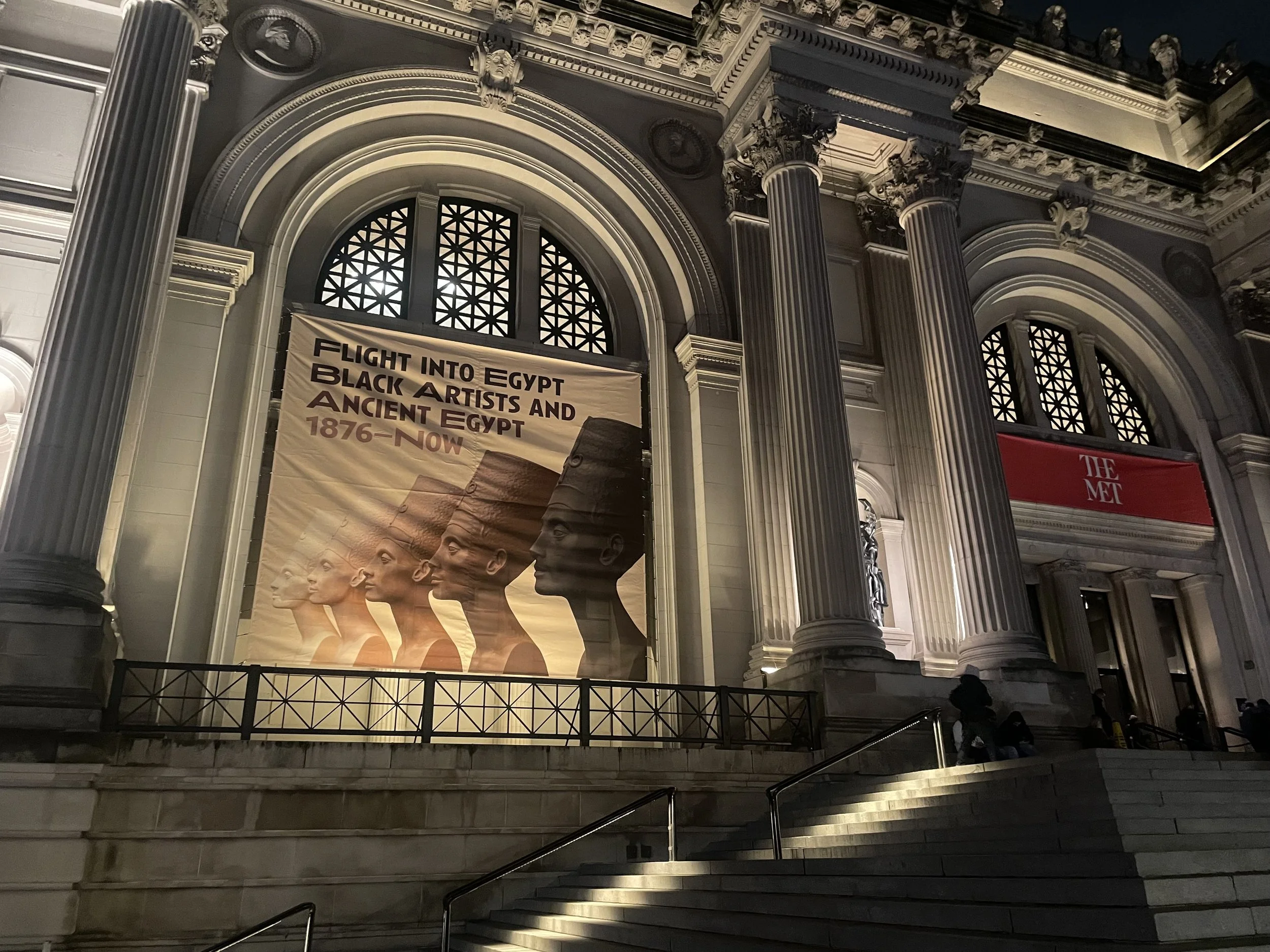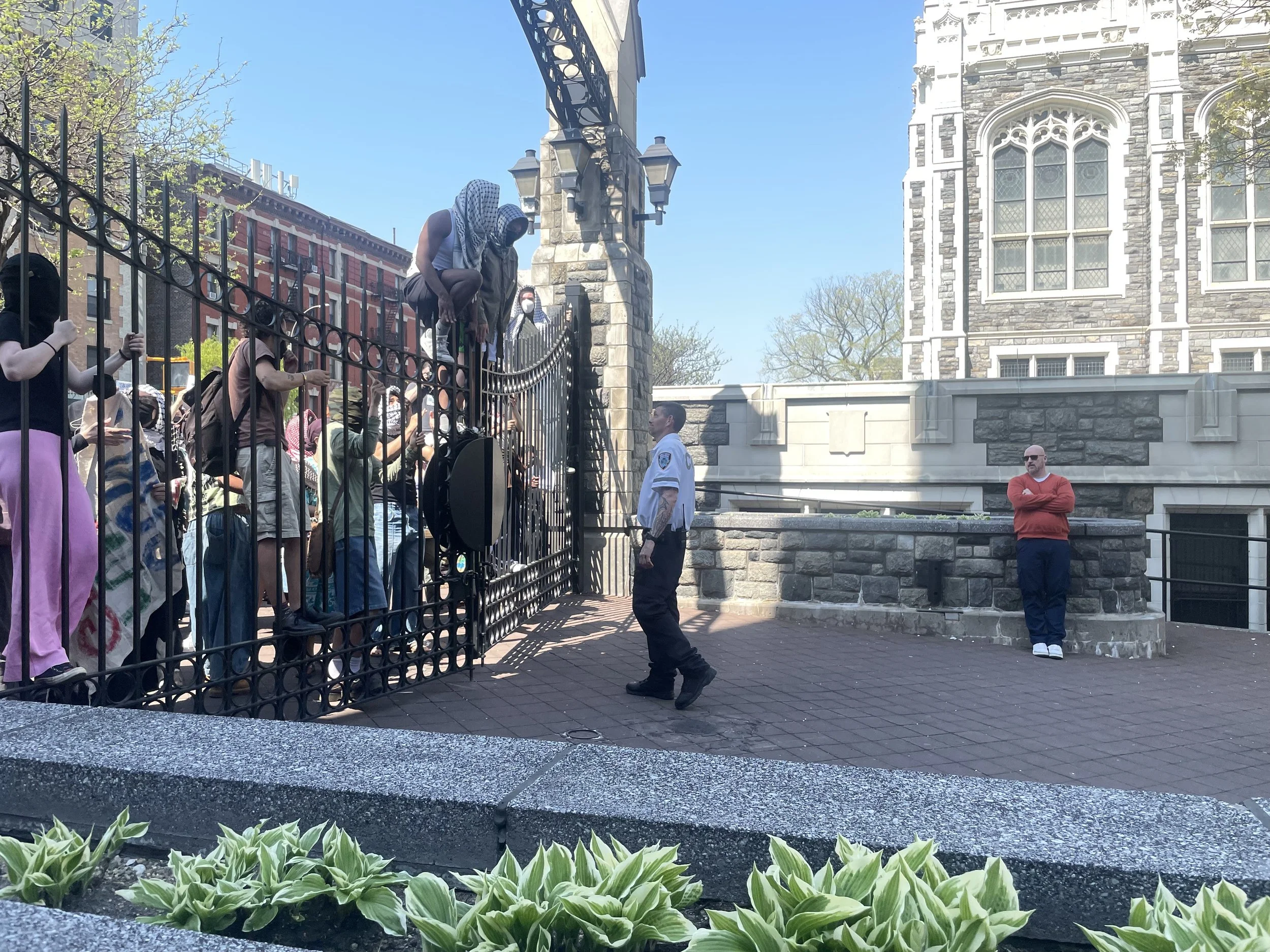Harlem Artists Take Flight Into Egypt In MET Exhibition
Above: The banner for Flight into Egypt hangs outside the Met.
This article was published as part of The Campus Spring 2025 edition
Photos and article by Leon Orlov-Sullivan
The ethnic makeup of ancient Egyptians has long sparked debate and curiosity, from accusations of whitewashing towards the 2014 film Exodus: Gods and Kings, which cast white actors in nearly all major roles to Egyptian outroar over Black British actress Adele James’ role as Cleopatra in a 2023 Netflix docuseries. These controversies highlight how the portrayal of ancient Egyptians, who lived before the development of modern conceptions of race, continues to ignite reactions. While ancient Egyptians had a unique genetic makeup and depicted themselves as reddish-brown, even Egyptologists have “projected their own racial anxieties onto ancient Egypt,” according to Middle Eastern history professor Donald Reid.
The Met’s exhibition Flight into Egypt: Black Artists and Ancient Egypt, 1876-Now, which ran until February 17, started with an acknowledgment of this history, showcasing Fred Wilson’s 1993 sculpture Grey Area (Brown Version) on its poster. By featuring five monochrome recreations of the iconic bust of Nefertiti in a wide gradient of human skin tones, the artist posed the question of the ancient Egyptians’ racial classification, but “intended neither to present or espouse a final thesis,” according to an essay written by Wilson for the catalogue accompanying Flight Into Egypt.
Flight into Egypt takes a look at how Black artists have interacted with Ancient Egypt, by contextualizing their relationship within the broader context of Black history, from Reconstruction to today. Through the inclusion of a diverse array of media from Black artists such as Jean-Michel Basquiat, Aaron Douglas, and Sun-Ra, the exhibition focuses on how Black artists, writers, and political figures have drawn inspiration from and, identified with ancient Egyptians as a sign of African achievement in the context of a society that doubts the abilities of Black people.
Artworks by Aaron Douglas, a staple of the Harlem Renaissance and chief art critic of The Crisis, show inspiration from ancient Egypt.
One room of the exhibition is quite different from the standard museum gallery room. Steffani Jemison and Jamal Cyrus’ 2011 Alpha’s Bet Is Not Over Yet installation is a reading and discussion room with reprinted Harlem Renaissance-era copies of The Crisis, the N.A.A.C.P. 's magazine since 1910, on shelves surrounding desks. The installation invites attendees to read through and discuss the magazines, which feature poems, articles on issues affecting Black people, commercials, and artworks, giving the interacting viewer a first-hand look into the cultural, political, and economic world of early 20th-century Black Americans. The Crisis, which was published in Baltimore, was a cornerstone of the Harlem Renaissance. Founded by W.E.B. Dubois, it published contributions from Langston Hughes, Countee Cullen, Zora Neale Hurston, and other figures whose writing defined the era.
In addition, a “significant portion reflects Black communities’ claims to and sustained interest in ancient Egypt.” Artworks in an adjacent room by the Harlem artist Aaron Douglas, who served as The Crisis’ art critic, include stylistic, thematic, and iconographic references to ancient Egypt. Building More Stately Mansions (1944), juxtaposes the Egyptian sphinx and pyramid with laborers holding modern architectural tools, honoring “the past and future labors of people of African descent” according to the exhibition’s description. Moreover, Let My People Go (1935-1939) depicts Egyptians as Black Africans in the depiction of the Biblical Exodus while also reflecting “the Black American affiliation with the plight of the biblical Israelites.” The exhibition’s featuring of Alpha’s Bet Is Not Over Yet and the works by Aaron Douglas highlights how Black artists, writers, and thinkers of the Harlem Renaissance took ancient Egypt as a demonstration of African achievement.
In the installation Alpha’s Bet Is Not Over Yet (2011), people read from early 20th-century editions of The Crisis, a staple of the Harlem Renaissance.
The exhibition concludes by highlighting three permanent art installations at MTA stations in Harlem. One of these, Harlem-based artist Maren Hassinger’s Message from Malcolm mosaic (1998) at the 110th Street 2 and 3 subway station, presents the quote “I lived in Egypt. I stayed in Egypt, and I was among brothers and I felt the spirit of brotherhood,” presenting an African connection between Egyptians and Black Americans. Another, Terry Adkin’s 1999 Harlem Encore at the 125th Street MNR station, features the ancient Egyptian sphinx. The inclusion of these artworks shows the ongoing presence of Egypt in the work of Black artists, exemplifying how, as it reads at the exhibition's entrance, “Black agents of culture have employed ancient Egyptian imagery to craft a unifying identity.”






